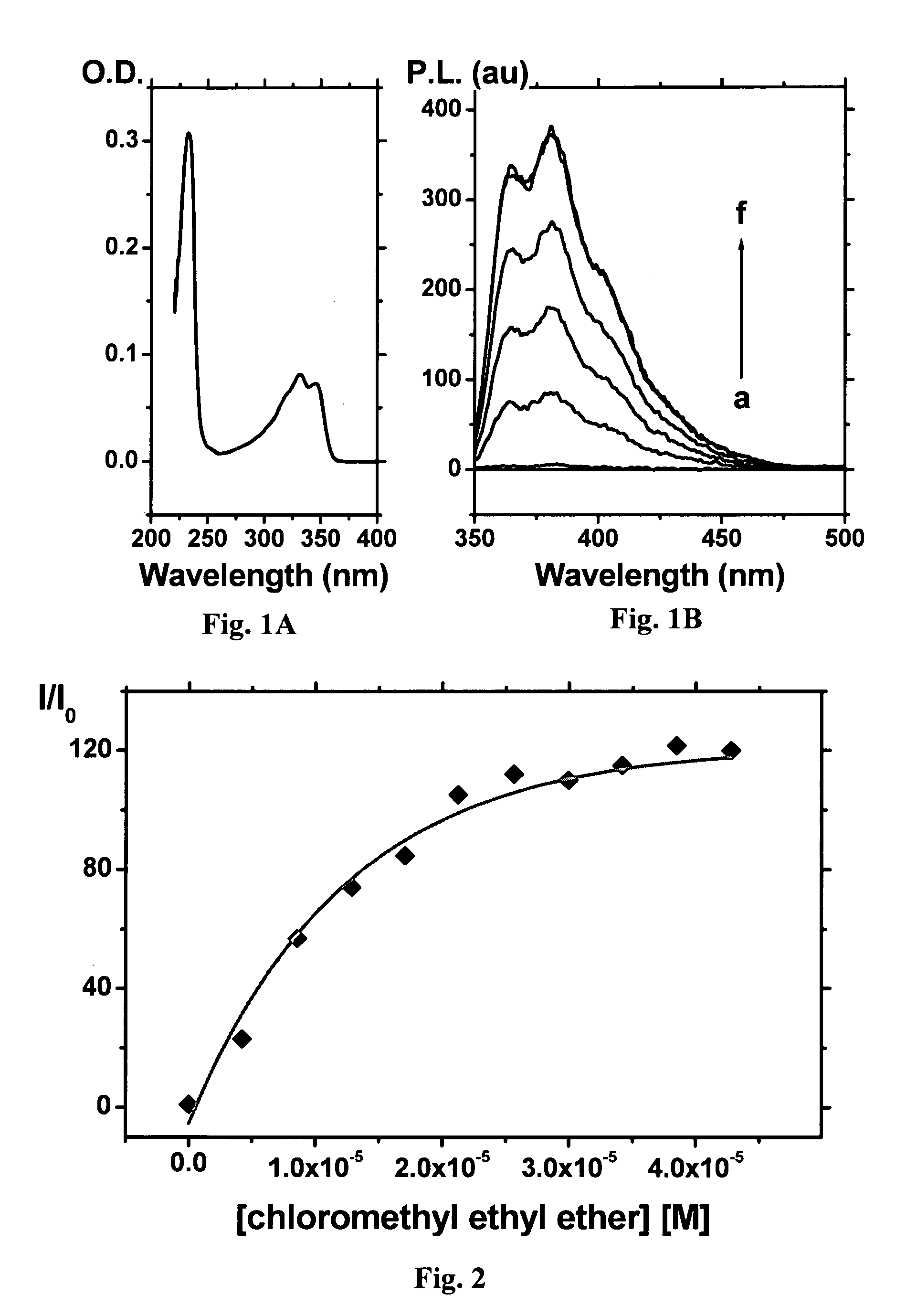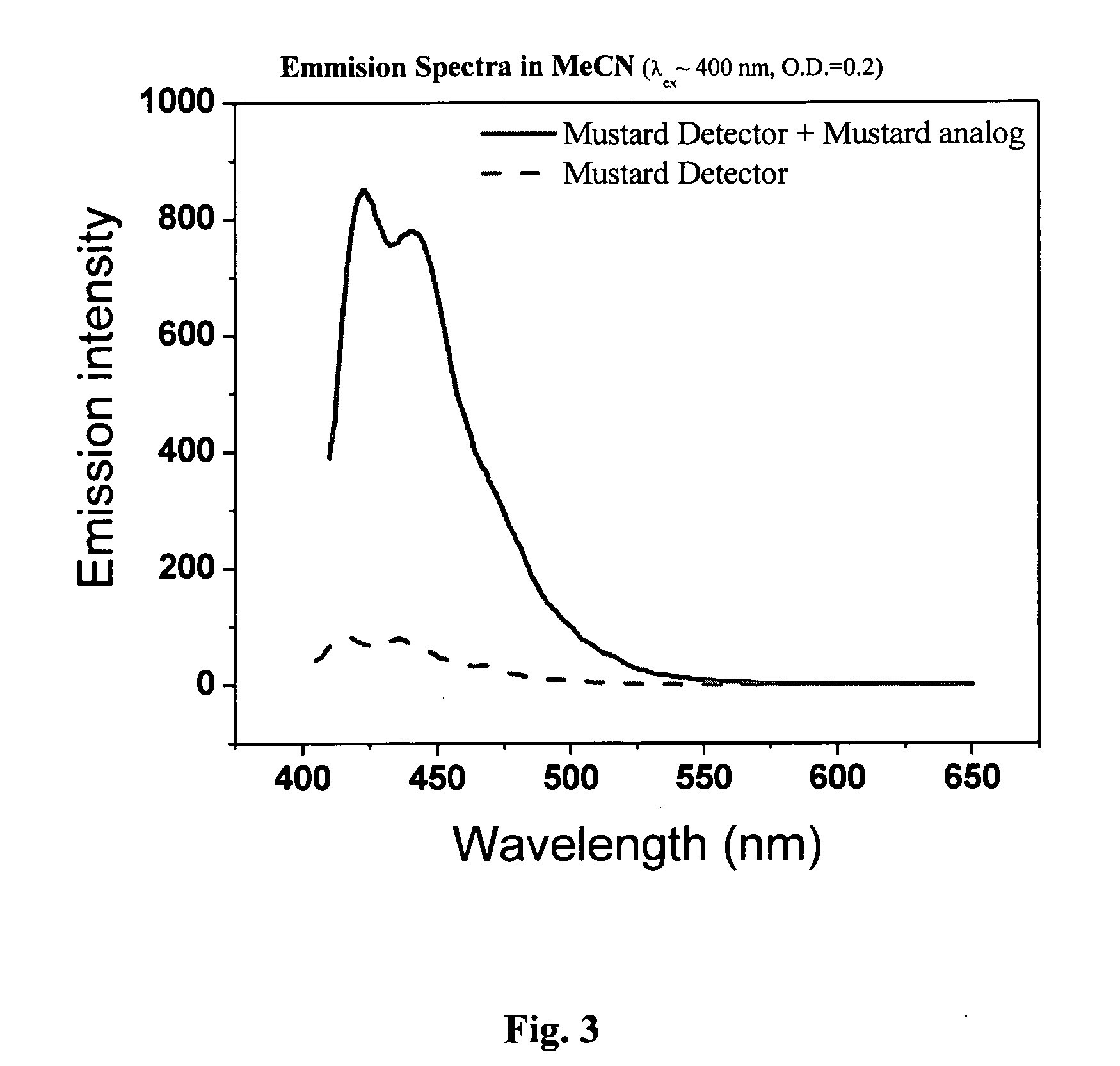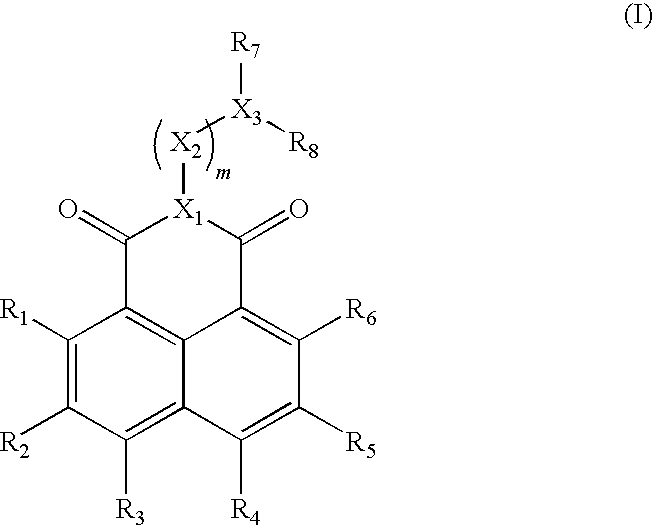Method for Detecting Alkylating Agents
a technology of alkylating agent and detection method, which is applied in the direction of material magnetic variables, instruments, and material analysis, can solve the problems of many of these materials, especially methylating agents, being toxic and/or mutagenic, and achieves simple or complex shapes
- Summary
- Abstract
- Description
- Claims
- Application Information
AI Technical Summary
Benefits of technology
Problems solved by technology
Method used
Image
Examples
example 1
Solid State Sensing of Alkylating Agents Using N-(2-dimethylaminoethyl)-1,8-naphthalimide (Compound 1)
[0162]A filter paper (Whatman) was dipped in a solution of the Compound 1 (20 mg / mL) in acetonitrile for 1 min. The filter paper was left to dry in the dark, then placed in a Teflon holder. The Teflon holder was fitted into one of two ground joints of a round-bottomed flask. The second joint was fitted with a tube that contained calcium chloride beads. The Teflon holder was connected to a vacuum pump that aspirated the atmosphere of the flask through the filter paper. The experiment was performed by placing the relevant alkylating agent (selected from chloroethylmethyl ether, chloroethylmethyl thioether, dichloromethyl or benzyl chloride), in the amount of 10 mg each and Na2CO3 (10 mg) at the bottom of a two-necked round-bottomed flask, then allowing the system to equilibrate for about 30 min and then aspirating the atmosphere of the flask for different periods of time.
[0163]Upon dr...
example 2
Synthesis of 4,6-dietoxy-1,8-naphthalimide (Compound 2)
[0168]The synthesis of Compound 2 having both a luminescent moiety (dietoxy-1,8-naphthalimide) and a nucleophilic moiety (1,1-dimethyl alkyl amine) was undertaken in 5 synthetic steps (a-e) as detailed herein below and in Scheme 1.
Step (a)-5,6-Dibromoacenaphthene [Ref. 5]
[0169]A suspension of N-bromosuccinimide (NBS) (25 gr, 143 mmol) in DMF (50 ml) was added in portions to an ice-cooled suspension of acenaphthene (10 g, 65 mmol) in DMF (15 mL) over a period of 1 h. The temperature of mixture was not allowed exceed 15° C. The mixture was stirred for a further 12 h and then allowed to warm to room temperature. The precipitate was filtered with suction, washed with ethanol (3×50 mL), and purified by stirring over night in refluxing ethanol (200 ml). Cooling to room temperature, filtration, washing with ethanol, and drying in vacuo yielded 4.5 g (22%) of a beige crystalline solid (m.p. 169-172° C.) that was suitable for further wor...
example 3
Solid State Sensing of Chlorodiethyl Thioether Using N-(2-dimethylaminoethyl)-4,6-diethoxy-1,8-naphthalimide (Compound 2)
[0181]The ability of Compound 2 in sensing chlorodiethyl thioether was tested similarly to the procedure detailed in Example 1 above. The reaction between the electrophile and the chemosensor is depicted in Scheme 2.
[0182]As FIG. 3 demonstrates, the presence of the electrophile turns caused a marked change in the emission spectrum of the chemosensor molecule designated Compound 2. In the absence of the electrophile, the emission was substantially quenched.
PUM
 Login to View More
Login to View More Abstract
Description
Claims
Application Information
 Login to View More
Login to View More - R&D
- Intellectual Property
- Life Sciences
- Materials
- Tech Scout
- Unparalleled Data Quality
- Higher Quality Content
- 60% Fewer Hallucinations
Browse by: Latest US Patents, China's latest patents, Technical Efficacy Thesaurus, Application Domain, Technology Topic, Popular Technical Reports.
© 2025 PatSnap. All rights reserved.Legal|Privacy policy|Modern Slavery Act Transparency Statement|Sitemap|About US| Contact US: help@patsnap.com



